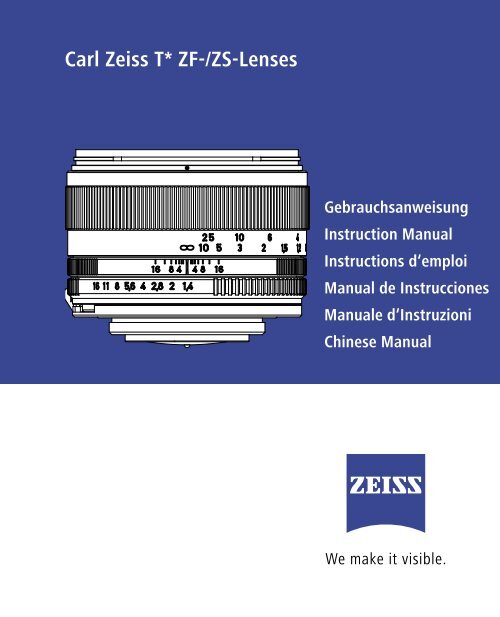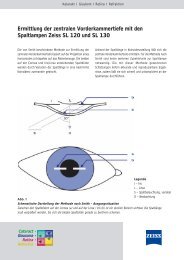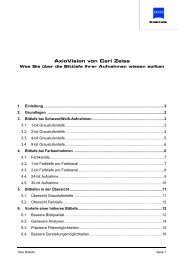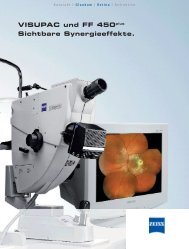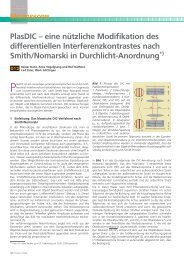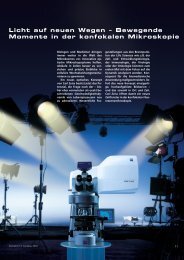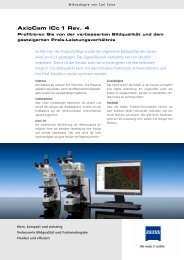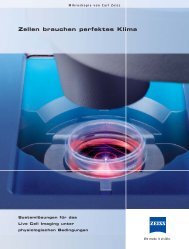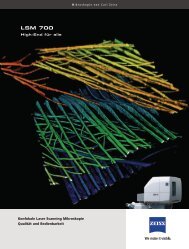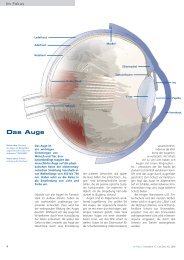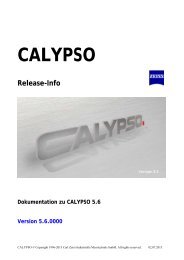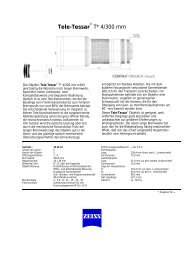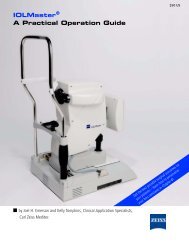Instruction Manual: ZF/ZS Lenses - Carl Zeiss
Instruction Manual: ZF/ZS Lenses - Carl Zeiss
Instruction Manual: ZF/ZS Lenses - Carl Zeiss
You also want an ePaper? Increase the reach of your titles
YUMPU automatically turns print PDFs into web optimized ePapers that Google loves.
<strong>Carl</strong> <strong>Zeiss</strong> T* <strong>ZF</strong>-/<strong>ZS</strong>-<strong>Lenses</strong><br />
Gebrauchsanweisung<br />
<strong>Instruction</strong> <strong>Manual</strong><br />
<strong>Instruction</strong>s d‘emploi<br />
<strong>Manual</strong> de Instrucciones<br />
<strong>Manual</strong>e d‘Instruzioni<br />
Chinese <strong>Manual</strong><br />
We make it visible.
4 Deutsch DE<br />
14 English UK<br />
24 Français FR<br />
34 Español ES<br />
44 Italiano IT<br />
54 Chinese CI<br />
2
3<br />
6<br />
1 7<br />
5<br />
2<br />
3<br />
4
DE<br />
4<br />
<strong>Carl</strong> <strong>Zeiss</strong> T* <strong>ZF</strong>- und <strong>ZS</strong>-Objektive –<br />
für überlegene Bildqualität<br />
Wir gratulieren Ihnen zum Kauf dieses Objektivs. Wir<br />
sind überzeugt, daß es Ihnen viel Freude und Erfolg beim<br />
Fotografieren bereiten wird.<br />
Außergewöhnlich gute Objektive zu konstruieren und herzustellen,<br />
das ist sehr anspruchsvoll. Wissenschaftliche und technologische<br />
Spitzenleistungen sind dafür unverzichtbar, vor allem<br />
aber – Leidenschaft!<br />
<strong>Carl</strong> <strong>Zeiss</strong> produziert seit 1846 Spitzenprodukte der Präzisions-<br />
technik und ist heute der führende Hersteller der anspruchsvollsten<br />
Objektive der Welt: Lithografieoptik für die Mikrochip-<br />
Fabrikation. Auch bei Objektiven für Spielfilm-Produktion, wo die<br />
Bilder auf der Leinwand oft tausendfach vergrößert werden, und<br />
die Qualität der Farbwiedergabe entscheidend ist, ist <strong>Carl</strong> <strong>Zeiss</strong><br />
heute Weltmarktführer. Und nun setzt <strong>Carl</strong> <strong>Zeiss</strong> seine Leidenschaft,<br />
sein Fachwissen und seine Spitzentechnologie auch für<br />
passionierte Fotografen ein.<br />
Das Ergebnis sind einzigartige Hochleistungsobjektive: die <strong>ZF</strong>-<br />
und <strong>ZS</strong>-Objektive.
<strong>ZF</strong>-Objektive von <strong>Carl</strong> <strong>Zeiss</strong> sind für die Verwendung an<br />
Nikon-Spielgelreflexkameras mit F (AI-S) Bajonett konstruiert<br />
und sind voll kompatibel mit allen Kameras mit F-Bajonett der<br />
vergangenen 40 Jahre. Sie besitzen ein für dieses Kamerasystem<br />
übliches Filtergewinde, das ebenso wie das Bajonett<br />
aus verschleißfestem, langlebigem Hartchrom gefertigt ist. Die<br />
Störlichtblenden (im Lieferumfang enthalten) wurden speziell<br />
auf die <strong>ZF</strong>-Objektive angepaßt, und das vordere Bajonett hilft<br />
beim schnellen, sicheren und akkuraten Ansetzen.<br />
Die <strong>ZS</strong>-Objektive von <strong>Carl</strong> <strong>Zeiss</strong> wurden für die Verwendung<br />
an Kameras mit dem klassischen Schraubgewinde M 42 (das<br />
ursprünglich ebenfalls von <strong>Carl</strong> <strong>Zeiss</strong> stammt) entwickelt. Per<br />
„M 42 Adapter“, der überall erhältlich ist, passen sie außerdem<br />
an viele moderne Hochleistungs-Spiegelreflexkameras und<br />
machen die überlegene Bildqualität von <strong>Carl</strong> <strong>Zeiss</strong> Hochleistungsoptik<br />
auch für diese Kameras verfügbar.<br />
DE<br />
5
DE Highlights der <strong>ZF</strong>- und <strong>ZS</strong>-Objektivfamilie:<br />
n ausgezeichnete Bildqualität<br />
n präzise, langlebige Mechanik<br />
n feinfühlige, manuelle Fokussierung<br />
n perfekt angepaßt für die Analog- sowie Digitalfotografie<br />
n hervorragende Störlicht-Absorption für faszinierend<br />
brillante Bilder<br />
n geometrische Verzeichnung hervorragend korrigiert<br />
n einheitlich neutrale Farbwiedergabe, wie bei professionellen<br />
Filmobjektiven<br />
n ästhetische Wiedergabe von Details außerhalb der Schärfentiefe<br />
(Bokeh1 ) durch spezielles Optik-Design und nahezu<br />
kreisförmige Neun-Lamellen-Blende<br />
6<br />
1 Wiedergabe von Bildbereichen außerhalb der Schärfenebene. Jedes Objektiv<br />
vermittelt damit einen eigenen charakteristischen Bildeindruck.<br />
Vorderer Schutzdeckel<br />
Der Schutzdeckel läßt sich durch gleichzeitiges Drücken der<br />
beiden Tasten am Rand des Deckels abnehmen und aufsetzen.<br />
Wenn am Objektiv eine Störlichtblende aufgesetzt ist, kann<br />
der Deckel durch Eingreifen in die Fingermulde abgenommen<br />
werden, die von der Vorderseite zugänglich ist.
<strong>ZF</strong>-Objektiv ansetzen und abnehmen<br />
Fassen Sie zunächst das Objektiv an den Rillen des Schärfentiefenrings.<br />
Richten Sie die Indexmarke in der Mitte der<br />
Schärfentiefeskala mit der Markierung am Kameragehäuse aus<br />
und setzen Sie das Objektiv in das Kamerabajonett ein. Drehen<br />
Sie das Objektiv gegen den Uhrzeigersinn (von der Vorderseite<br />
aus gesehen) bis es hörbar und spürbar einrastet.<br />
Um das Objektiv abzunehmen, fassen Sie es an den Rillen des<br />
Schärfentiefenrings. Halten Sie den Objektiv-Entriegelungsknopf<br />
an der Kamera gedrückt und drehen Sie das Objektiv im<br />
Uhrzeigersinn.<br />
<strong>ZS</strong>-Objektiv ansetzen und abnehmen<br />
Fassen Sie zunächst das Objektiv an den Rillen des Schärfentiefenrings.<br />
Schrauben Sie das Objektiv im Uhrzeigersinn (von<br />
der Vorderseite aus gesehen) in das Objektiv-Gewinde des<br />
Kameragehäuses, bis es fest anliegt. Die Indexmarke der Entfernungsskala<br />
sollte sich nun oben befinden. Um das Objektiv<br />
abzunehmen, fassen Sie es an den Rillen des Schärfentiefenrings.<br />
Schrauben Sie das Objektiv gegen den Uhrzeigersinn aus<br />
der Kamera heraus.<br />
DE<br />
7
DE Anbringen und Abnehmen von Filtern und<br />
Störlichtblenden<br />
Filter mit Standardgewinde lassen sich an der Objektivvorderseite<br />
einschrauben. Wenn Sie mehr als einen Filter gleichzeitig<br />
verwenden, kann Vignettierung (Abschatten der Bildecken)<br />
auftreten.<br />
Zum Aufsetzen der Störlichtblende setzen Sie diese mit dem<br />
weißen Punkt am Index für die Störlichtblende am Objektiv<br />
an. Drücken Sie die Störlichtblende gegen das Objektiv und<br />
drehen sie dann im Uhrzeigersinn, bis sie sicher einrastet. Um<br />
die Störlichtblende abzunehmen, drehen Sie sie entgegen dem<br />
Uhrzeigersinn. Für Transport und Aufbewahrung kann die<br />
Störlichtblende auch umgekehrt angebracht werden.<br />
8<br />
Objektivkomponenten<br />
1 Blendenskala<br />
2 Blenden-/Entfernungsindex<br />
3 Fokussierring<br />
4 Entfernungsskala<br />
5 Schärfentiefeskala<br />
6 Infrarotindex<br />
7 Index für Störlichtblende
Tips zur Pflege des Objektivs<br />
Damit Ihr Objektiv stets in bestem Zustand bleibt, sollten Sie<br />
jegliche Verunreinigungen und Feuchtigkeit auf den Glasflächen<br />
vermeiden. Staub auf dem Objektivglas kann vorsichtig mit<br />
einem weichen Pinsel entfernt werden, Flecken und Fingerabdrücke<br />
mit einem trockenen, sauberen und weichen Baumwolltuch.<br />
Wir empfehlen besonders das ZEISS Lens Cleaning Kit.<br />
Kundendienst<br />
Ihren nächstgelegenen Händler finden Sie auf der Homepage<br />
www.zeiss.de/photo.<br />
DE<br />
9
DE Die Perspektive des menschlichen Sehens – lichtstark,<br />
scharf, farbrein<br />
Das Objektiv Planar T* 1,4/50 <strong>ZF</strong>/<strong>ZS</strong> ist ein besonders lichtstarkes<br />
Standardobjektiv für anspruchsvolle Fotografie mit<br />
Kleinbild-Spiegelreflexkameras (SLR). Erfahrenen Fotografen<br />
und Testern gilt es als das beste SLR-Standardobjektiv der<br />
Welt. Mit seiner präzisen Fokussiermechanik ermöglicht es<br />
sehr genaues, manuelles Scharfstellen. Es ist verfügbar für<br />
Nikon F (AI-S) Bajonett sowie für M42-Schraubgewinde. Seine<br />
Abbildungsleistung nutzt die Möglichkeiten der besten Farbfilme<br />
technisch und ästhetisch voll aus. Die herausragend gute<br />
Farbwiedergabe und Brillanz setzt Maßstäbe und bietet auch<br />
beste Voraussetzungen für hochwertige Digitalfotos.<br />
10<br />
Planar T* 1,4/50 <strong>ZF</strong>,<br />
Planar T* 1,4/50 <strong>ZS</strong>
Technische Daten<br />
Brennweite: 50 mm<br />
Blendenbereich: f /1,4 – f /16,<br />
mit Rastungen in<br />
halben Blendenstufen<br />
Fokussierbereich: 0,45 m – ∞<br />
Bildwinkel, diagonal /horizontal: 46°/39°<br />
Objektfeld bei kleinster Naheinstellung: 16 cm x 24 cm<br />
Anzahl Elemente /Glieder: 7/6<br />
Filter-Gewinde: M 58 x 0,75<br />
Gewicht: 330 g<br />
Maße (mit Deckeln): Ø 66 mm,<br />
Länge 69 mm (<strong>ZF</strong>)<br />
Produktnummer, Planar T* 1,4 /50 <strong>ZF</strong> 102250<br />
Produktnummer, Planar T* 1,4 /50 <strong>ZS</strong> 102252<br />
DE<br />
11
DE Der konzentrierte Blick – lichtstark, detailreich,<br />
verzeichnungsfrei<br />
Das Objektiv Planar T* 1,4/85 <strong>ZF</strong> ist ein besonders lichtstarkes<br />
Kurz-Tele für anspruchsvolle Fotografie mit Kleinbild-Spiegelreflexkameras.<br />
Es liefert ein ungewöhnlich helles, klares<br />
Sucherbild. Schon bei voller Öffnung bietet es hohe Bildqualität.<br />
Kenner nutzen es deshalb gern für das Porträtieren<br />
„on location“ oder im Studio. Die geringe Schärfentiefe bei<br />
weiter Blendenöffnung erlaubt das visuelle Freistellen des<br />
Motivs durch gezielten Einsatz der Hintergrund-Unschärfe.<br />
Das „Bokeh“ dieses Objektivs, die ästhetische Wiedergabe von<br />
Bildbereichen abseits der Fokusebene, ist durch den speziellen<br />
optischen Aufbau und die Neun-Lamellen-Blende mit nahezu<br />
kreisförmiger Geometrie herausragend. Eine Verzeichnung ist<br />
praktisch nicht erkennbar – das schafft die Voraussetzungen<br />
für hochwertige Dokumentationsfotos, analog und digital.<br />
12<br />
Planar T* 1,4/85 <strong>ZF</strong>
Technische Daten<br />
Brennweite: 85 mm<br />
Blendenbereich: f /1,4 – f /16,<br />
mit Rastungen in<br />
halben Blendenstufen<br />
Fokussierbereich: 1 m – ∞<br />
Bildwinkel, diagonal /horizontal: 28,5°/24°<br />
Objektfeld bei kleinster Naheinstellung: 24 cm x 36 cm<br />
Anzahl Elemente /Glieder: 6 /5<br />
Filter-Gewinde: M 72 x 0,75<br />
Gewicht: 570 g<br />
Maße (mit Deckeln): Ø 77 mm,<br />
Länge 86 mm<br />
Produktnummer, Planar T* 1,4 /85 <strong>ZF</strong> 102251<br />
<strong>Carl</strong> <strong>Zeiss</strong> behält sich das Recht vor, die genannten Spezifikationen ohne<br />
vorherige Mitteilung zu ändern.<br />
Alle Rechte vorbehalten. Diese Anleitung, oder Bestandteile davon, darf ohne<br />
vorherige schriftliche Genehmigung von <strong>Carl</strong> <strong>Zeiss</strong> nicht vervielfältigt, in Wiedergabesystemen<br />
gespeichert oder in irgendeiner Form übertragen werden, sei es<br />
elektronisch, mechanisch, durch Fotokopie, Aufzeichnung oder andere Medien.<br />
Copyright 2005, <strong>Carl</strong> <strong>Zeiss</strong> AG<br />
DE<br />
13
UK<br />
14<br />
<strong>Carl</strong> <strong>Zeiss</strong> T* <strong>ZF</strong>- and <strong>ZS</strong>-<strong>Lenses</strong> –<br />
for Superior Images<br />
Thank you and congratulations for purchasing this<br />
<strong>Carl</strong> <strong>Zeiss</strong> T* lens. We are confident that you will enjoy<br />
exceptional photographic success with your new lens.<br />
Outstanding lenses are designed and manufactured in an intricate<br />
process involving science, technology – and passion. <strong>Carl</strong><br />
<strong>Zeiss</strong>’s capability for extreme precision, allied with cutting-edge<br />
technological mastery, is evident in the optics we make for<br />
micro-chip fabrication. We set the world standard and we are<br />
the world’s leading maker in this field. In the field of cinematography<br />
lenses, where images are often enlarged 1000 times,<br />
and color uniformity is critical, <strong>Carl</strong> <strong>Zeiss</strong> is also the world<br />
leader. Here, our passion for creating the ultimate imaging tool<br />
plays an important role in guiding the science and technology<br />
we apply to the design and manufacture of our lenses.<br />
Technologically inspired passion, based on the extensive<br />
experience and know-how we have gained since 1886, is the<br />
formula we are now incorporating into the high-performance<br />
<strong>Carl</strong> <strong>Zeiss</strong> <strong>ZF</strong>- and <strong>ZS</strong>-lenses. Never before has this unique<br />
combination been available to such a broad spectrum of passionate<br />
still photographers.
The <strong>Carl</strong> <strong>Zeiss</strong> <strong>ZF</strong>-lenses are designed for use with Nikon SLR<br />
cameras with the standard Nikon F (AI-S) bayonet and are<br />
completely compatible with all cameras using the F mount<br />
over the last 40 years. Standard filters may be threaded onto<br />
the lens. Our accessory shades (included) guarantee maximum<br />
efficiency while the bayonet fitting allows quick, secure, and<br />
accurate mounting.<br />
The <strong>Carl</strong> <strong>Zeiss</strong> <strong>ZS</strong>-lenses are designed for use on cameras with<br />
M 42 “Universal” thread mount (also a <strong>Carl</strong> <strong>Zeiss</strong> development).<br />
Using widely available M 42 adapters, these lenses also make<br />
the superior <strong>Carl</strong> <strong>Zeiss</strong> image quality available to many other<br />
SLR cameras.<br />
UK<br />
15
UK<br />
16<br />
Highlights of the <strong>ZF</strong>- and <strong>ZS</strong>-lens family:<br />
n excellent optical performance<br />
n manual focusing with the smooth feeling of high precision<br />
and durable mechanics<br />
n perfectly adapted for film and digital photography<br />
n highly advanced flare control for crisp and brilliant images<br />
n geometric distortion very well corrected<br />
n color-matched lenses for superior consistent color reproduc-<br />
tion, as featured in professional motion picture lenses<br />
n beautiful out-of-focus zones (bokeh 1 ) due to optical design<br />
and 9-blade iris with near circular shape<br />
1 Rendition of image detail outside the plane of sharp focus. Each lens design<br />
shows its own characteristic way of imaging.<br />
Front cap<br />
The lens cap is removed and attached by pressing the two<br />
buttons on the rim of the cap inwards. When a lens hood is<br />
attached, the cap can be removed by gripping into the finger<br />
slot of the cap, which is accessible from the front.
Attaching and removing the <strong>ZF</strong>-lens<br />
Grip the lens at the grooves of the depth of field ring. Align the<br />
index mark in the middle of the depth of field scale with the<br />
index on the camera body and insert the lens into the bayonet.<br />
Turn the lens counter-clockwise (seen from the front) until it<br />
clicks and the lens is locked. Remove the lens by gripping it at<br />
the grooves of the depth of field ring. Turn the lens clockwise<br />
while depressing the lens release knob on the camera.<br />
Attaching and removing the <strong>ZS</strong>-lens<br />
Grip the lens at the grooves of the depth of field ring. Screw<br />
the lens into the thread mount of the camera by turning it<br />
clockwise (seen from the front), until it is fixed (the index of the<br />
distance scale should then be on the top side). Remove the lens<br />
by gripping it at the grooves of the depth of field ring. Turn the<br />
lens counter-clockwise, until you feel the lens released by the<br />
camera thread mount.<br />
UK<br />
17
UK<br />
18<br />
Attaching and removing filters, lens shade<br />
Standard threaded filters can be attached to the front of the<br />
lens. If you use more than one filter at a time mechanical<br />
vignetting may occur.<br />
To attach the shade in operation mode, align the white dot on<br />
the shade with the shade index on the lens. Turn the shade<br />
clockwise until it clicks into its locked position. Remove the<br />
shade by turning it counter-clockwise. The shade can also be<br />
attached in reverse mode for transportation and storage.<br />
Lens components<br />
1 Aperture scale<br />
2 Aperture index /Center index<br />
3 Focusing ring<br />
4 Distance scale<br />
5 Depth of field scale<br />
6 Infrared index<br />
7 Shade index
Tips for lens care<br />
To avoid any imperfections and humidity on the front lens surface,<br />
and for general protection, it is recommended to use the<br />
lens cap as much as possible when the lens is not in use. Dust,<br />
smudges and fingerprints on the lens surface can be gently<br />
removed with a very soft brush and then with a dry, clean,<br />
soft cotton cloth. The ZEISS lens cleaning kit will give superior<br />
results and is highly recommended for this purpose.<br />
Customer Service<br />
The website www.zeiss.com/photo will guide you to your<br />
nearest dealer.<br />
UK<br />
19
UK<br />
20<br />
Planar T* 1.4/50 <strong>ZF</strong>,<br />
Planar T* 1.4/50 <strong>ZS</strong><br />
The perspective of the human eye – high speed, top<br />
sharpness, color clarity<br />
The Planar T* 1.4/50 <strong>ZF</strong>/<strong>ZS</strong> lens is a high speed standard<br />
lens for the exacting 35 mm SLR photographer. Experienced<br />
professionals and testing lab specialists rate this lens as the<br />
best standard SLR lens available world wide. Its precision<br />
mechanical construction allows highly accurate manual focusing.<br />
Its imaging performance allows full use of the best color<br />
films’ technical and aesthetic properties. Its outstanding color<br />
rendition and brilliance set the standard for film photography<br />
and provide the prerequisites for top quality digital photographs<br />
as well.
Technical specifications<br />
Focal length: 50 mm<br />
Aperture range: f /1.4 – f /16,<br />
clickstopped in<br />
1 ⁄ 2 stop intervals<br />
Focusing range: 0.45 m (18”) – ∞,<br />
from image plane<br />
Angle of view, diagonal /horizontal: 46° /39°<br />
Coverage at close range: 16 cm x 24 cm<br />
(6 1 ⁄2” x 9 3 ⁄4”)<br />
Optical construction: 7 elements/6 group<br />
Filter thread: M 58 x 0.75<br />
Weight: 330 g (11.6 oz)<br />
Overall dimensions (with caps): 66 mm diameter x<br />
69 mm long (<strong>ZF</strong>)<br />
2 5 /8” diameter x<br />
2 11 /16” long (<strong>ZF</strong>)<br />
Code, Planar T* 1.4 /50 <strong>ZF</strong> 102250<br />
Code, Planar T* 1.4 /50 <strong>ZS</strong> 102252<br />
UK<br />
21
UK<br />
22<br />
Planar T* 1.4 /85 <strong>ZF</strong><br />
The closer look – high speed, rich detail, absence of<br />
distortion<br />
The Planar T* 1.4 /85 <strong>ZF</strong>-lens is a short, high speed tele lens<br />
for the exacting SLR photographer. It provides an unusually<br />
bright and clear image in the finder. Even at full aperture, it<br />
delivers top image quality. Its angle of view and exceptional<br />
performance make the Planar T* 1.4 /85 <strong>ZF</strong> the lens of choice<br />
for portraiture on location or in the studio. Its shallow depth<br />
of field at wide apertures allows the use of selective focus to<br />
emphasize the primary subject by defocusing the background.<br />
The lens’s “bokeh,” (the imaging of out-of-focus zones), resulting<br />
from optical design and the 9-blade iris, is outstanding.<br />
Geometrical distortion is imperceptibly low, allowing high<br />
quality documentation photographs, both analog and digital.
Technical specifications<br />
Focal length: 85 mm<br />
Aperture range: f/1.4 – f /16<br />
clickstopped in<br />
1 ⁄2 stop intervals<br />
Focusing range: 1 m (3’ 4”) – ∞,<br />
from image plane<br />
Angle of view, diagonal /horizontal: 28.5° /24°<br />
Coverage at close range: 24 cm x 36 cm,<br />
(9 3 /8“ x 1’ 2”)<br />
Optical construction: 6 elements /5 groups<br />
Filter thread: M 72 x 0.75<br />
Weight: 570 g (1 lb 4.1 oz)<br />
Overall dimensions (with caps): 77 mm diameter x<br />
86 mm long<br />
3 1 /16” diameter x<br />
3 3 /8“ long<br />
Code, Planar T* 1.4 /85 <strong>ZF</strong> 102251<br />
<strong>Carl</strong> <strong>Zeiss</strong> AG reserves the right to make changes to the published<br />
specifications without prior notice.<br />
All rights reserved. No part of this material may be reproduced, stored in retrieval<br />
systems, or transmitted, in any form or by any means, electronic, mechanical,<br />
photocopy, recording, or otherwise without the prior written consent of <strong>Carl</strong><br />
<strong>Zeiss</strong>. Copyright 2005, <strong>Carl</strong> <strong>Zeiss</strong> AG<br />
UK<br />
23
FR<br />
24<br />
Objectifs <strong>ZF</strong> et <strong>ZS</strong> T* de <strong>Carl</strong> <strong>Zeiss</strong> :<br />
la garantie d’images exceptionnelles<br />
Nous vous remercions et vous félicitons d’avoir choisi cet<br />
objectif T* de <strong>Carl</strong> <strong>Zeiss</strong>. Nous sommes convaincus que<br />
cette nouvelle acquisition vous permettra de réussir de<br />
très belles images photographiques.<br />
Des objectifs hauts de gamme sont conçus et fabriqués au<br />
cours d’un processus complexe qui implique les sciences, les<br />
techniques – et une passion. La compétence de <strong>Carl</strong> <strong>Zeiss</strong> pour<br />
la haute précision et sa maîtrise de technologies de pointe se<br />
révèlent par exemple dans les optiques que nous fabriquons<br />
pour les microprocesseurs (ou puces). Nous avons ainsi fixé<br />
la norme internationale et nous occupons le tout premier<br />
rang mondial dans ce domaine. Dans le secteur des objectifs<br />
cinématographiques, où les images sont souvent agrandies de<br />
1000 fois et lorsque les couleurs nécessitent des corrections,<br />
<strong>Carl</strong> <strong>Zeiss</strong> est aussi le leader mondial. Notre passion est de<br />
créer l’outil pour la référence ultime en imagerie; elle s’avère<br />
déterminante dans le choix des techniques que nous appliquons<br />
à la réalisation des objectifs photographiques.<br />
Cette passion, issue d’une longue expérience et d’un savoirfaire<br />
acquis depuis 1886, est concrétisée aujourd’hui dans les<br />
objectifs ultra-performants <strong>ZF</strong> et <strong>ZS</strong> de <strong>Carl</strong> <strong>Zeiss</strong>, désormais
disponibles à une gamme élargie d’appareils photographiques,<br />
pour de nombreux photographes exigeants.<br />
Les objectifs <strong>ZF</strong> de <strong>Carl</strong> <strong>Zeiss</strong> sont prévus pour équiper les appareils<br />
SLR Nikon (reflex mono-objectif) dotés des baïonnettes<br />
F (AI-S). Ils sont donc compatibles avec tous les boîtiers qui<br />
ont utilisé cette monture F au cours des 40 dernières années.<br />
Des filtres courants peuvent être vissés à l’objectif, seuls ou<br />
avec des parasoleils. Ceux-ci, en tant qu’accessoires optionnels,<br />
garantissent une efficacité maximale contre les lumières parasites,<br />
et leur fixation à baïonnette est sûre, rapide et précise.<br />
Les objectifs <strong>ZS</strong> de <strong>Carl</strong> <strong>Zeiss</strong> se fixent sur tous les appareils<br />
photographiques à monture à vis M42, dite « universelle »,<br />
(également mise au point par <strong>Carl</strong> <strong>Zeiss</strong>). Grâce à des adaptateurs<br />
M42 très répandus, de très nombreux autres boîtiers<br />
reflex peuvent aussi exploiter les qualités supérieures des<br />
objectifs <strong>ZS</strong> de <strong>Carl</strong> <strong>Zeiss</strong>.<br />
FR<br />
25
FR<br />
26<br />
Avantages des objectifs <strong>ZF</strong> et <strong>ZS</strong> de <strong>Carl</strong> <strong>Zeiss</strong> :<br />
n excellents rendus optiques<br />
n finesse et douceur de la mise au point manuelle, grâce à des<br />
mécanismes durables et de haute précision<br />
n traitement très avancé contre les reflets parasites, pour des<br />
images brillantes et nettes<br />
n adaptation parfaite à la cinématographie et à la photo-<br />
graphie numérique<br />
n distorsion géométrique très bien corrigée<br />
n correction des aberrations chromatiques pour un rendu<br />
fidèle des couleurs, selon les mêmes procédés utilisés pour<br />
les objectifs cinématographiques professionnels<br />
n très belles zones de flous dites « bokeh 1 », grâce à la concep-<br />
tion optique et au diaphragme à 9 iris, très proche de la<br />
forme circulaire<br />
1 Restitution des détails de l’image en dehors du plan de netteté. Par sa conception,<br />
chaque objectif présente son propre mode de formation d’image typique.<br />
Couvre-objectifs avant<br />
Le couvre-objectif est retiré et attaché par la simple pression des<br />
deux boutons aménagés sur son pourtour intérieur. Lorsqu’un<br />
parasoleil est fixé, le couvre-objectif est enlevé en saisissant<br />
l’encoche sur sa face avant.
Montage et démontage de l’objectif <strong>ZF</strong><br />
Tenir l’objectif par la bague moletée de réglage de la profondeur<br />
de champ. Aligner le repère disposé au milieu de l’échelle<br />
de la profondeur de champ sur celui gravé dans le boîtier de<br />
l’appareil photo, puis insérer l’objectif dans la baïonnette. Faire<br />
pivoter l’objectif dans le sens inverse des aiguilles d’une montre<br />
(vu de face) jusqu’à ce qu’il s’enclenche et qu’il soit ainsi verrouillé.<br />
Pour détacher l’objectif, saisir la bague de réglage de la<br />
profondeur de champ, puis la tourner dans le sens des aiguilles<br />
d’une montre, tout en appuyant sur le bouton de déblocage de<br />
l’objectif qui est aménagé sur le boîtier SLR.<br />
Montage et démontage de l’objectif <strong>ZS</strong><br />
Tenir l’objectif par la bague moletée de réglage de la profondeur<br />
de champ. Visser l’objectif à la monture filetée de l’appareil<br />
photo en le tournant dans le sens des aiguilles d’une montre<br />
(vu de face) jusqu’à ce qu’il soit bien fixé (le repère de l’échelle<br />
de mise au point doit alors se trouver sur le côté supérieur).<br />
Pour enlever l’objectif, saisir la bague de réglage de la profondeur<br />
de champ, puis la tourner dans le sens des aiguilles d’une<br />
montre jusqu’à ce qu’il se désolidarise de la monture filetée de<br />
l’appareil photo.<br />
FR<br />
27
FR<br />
28<br />
Montage et démontage des filtres, du parasoleil<br />
Des filtres à vis courants peuvent être fixés sur le devant de<br />
l’objectif. L’utilisation simultanée de plusieurs filtres risque de<br />
provoquer un vignetage mécanique.<br />
Pour fixer le parasoleil dans le mode opérationnel, aligner le<br />
point blanc figuré sur le parasoleil en face du repère correspondant<br />
sur l’objectif. Tourner le parasoleil dans le sens des<br />
aiguilles d’une montre jusqu’à ce qu’il s’enclenche dans sa<br />
position verrouillée. Retirer le parasoleil en le faisant pivoter<br />
dans le sens inverse des aiguilles d’une montre. Le parasoleil<br />
peut être aussi enclenché dans un mode inversé à des fins de<br />
transport et d’entreposage.<br />
Composants de l’objectif<br />
1 Echelle de diaphragmes<br />
2 Repère d’ouverture / repère de centrage<br />
3 Bague de mise au point<br />
4 Echelle de mise au point<br />
5 Echelle de réglage de la profondeur de champ<br />
6 Repère infrarouge<br />
7 Repère du parasoleil
Conseils d’entretien<br />
Pour prévenir toute altération et l’apparition d’humidité sur la<br />
face avant de l’objectif ainsi que pour en assurer la protection<br />
générale, il est conseillé d’employer le couvre-objectif dès que<br />
l’objectif n’est plus utilisé. Il est possible de supprimer la poussière,<br />
les taches et les traces de doigt à la surface de l’objectif<br />
en l’essuyant délicatement à l’aide d’un pinceau à poils très<br />
doux, puis avec un coton léger, propre et sec. Le kit de nettoyage<br />
d’objectif de ZEISS donne des résultats supérieurs. Il est<br />
donc vivement recommandé à cette fin.<br />
Service après-vente<br />
Notre site, que nous vous invitons à consulter à l’adresse<br />
www.zeiss.com/photo, vous indique les coordonnées du<br />
revendeur le plus proche de chez vous.<br />
FR<br />
29
FR<br />
30<br />
Planar T* 1,4 /50 <strong>ZF</strong>,<br />
Planar T* 1,4 /50 <strong>ZS</strong><br />
La perspective de la vision humaine : grande ouverture,<br />
netteté des contours et pureté des couleurs<br />
L’objectif Planar T* 1,4 /50 <strong>ZF</strong>/<strong>ZS</strong> représente la focale courante<br />
de prédilection des photographes exigeants, habitués aux boîtiers<br />
SLR 35mm. En effet, les professionnels et les spécialistes<br />
des laboratoires d’essais l’apprécient comme le meilleur objectif<br />
standard, disponible partout dans le monde. Sa construction<br />
mécanique durable garantit l’exactitude de sa mise au point<br />
manuelle. Ses potentialités permettent d’exploiter pleinement<br />
les propriétés esthétiques et techniques des meilleurs films en<br />
couleur. Enfin, il offre un rendu et une brillance des couleurs si<br />
remarquables qu’il sert de référence en haute qualité tant à la<br />
cinématographie qu’aux capteurs numériques.
Spécifications techniques<br />
Distance focale : 50 mm<br />
Plage de diaphragmes d’ouverture : f /1,4 – f /16 encliquetable<br />
par intervalles de 1 ⁄2<br />
Plage de mise au point : 0,45 m – ∞, par rapport<br />
au plan de l’image<br />
Angle de champ visuel<br />
diagonal / horizontal : 46° /39°<br />
Champ couvert en mise au point<br />
rapprochée : 16 cm x 24 cm<br />
Construction optique : 7 éléments /6 groupes<br />
Filetage de filtre : M 58 x 0,75<br />
Poids : 330 g (11 livre 6 onces)<br />
Dimensions totales<br />
(avec couvre-objectifs) : 66 mm de diamètre x<br />
69 mm de longueur (<strong>ZF</strong>)<br />
Code, Planar T* 1,4 /50 <strong>ZF</strong> 102250<br />
Code, Planar T* 1,4 /50 <strong>ZS</strong> 102252<br />
FR<br />
31
FR<br />
32<br />
Planar T* 1,4 /85 <strong>ZF</strong><br />
Le regard plus acéré : grande luminosité, richesse des<br />
détails et absence de distorsion<br />
L’objectif Planar T* 1,4 /85 <strong>ZF</strong> peut être considéré comme un<br />
téléobjectif court à grande ouverture, destiné aux photographes<br />
portraitistes utilisant des appareils SLR 35mm. Il offre une<br />
image très lumineuse et claire dans le viseur. Grâce à son angle<br />
de champ visuel et à ses performances exceptionnelles, l’objectif<br />
Planar T* 1,4 /85 <strong>ZF</strong> se prête à merveille à la réalisation de<br />
portraits dans une situation quotidienne ou en studio. Sa<br />
petite profondeur de champ à une grande ouverture permet de<br />
recourir à une mise au point sélective, pour ressortir un motif<br />
principal en défocalisant les autres zones de l’image. Générées<br />
par la conception optique et par un diaphragme en iris à 9<br />
lamelles, ces zones de flou ou « bokeh » présentent une très<br />
belle douceur. La distorsion géométrique est imperceptible.<br />
Elle garantit la création de photographies documentaires de<br />
haute qualité, tant pour les supports argentiques que dans les<br />
systèmes numériques.
Spécifications techniques<br />
Distance focale : 85 mm<br />
Plage de diaphragmes d’ouverture : f /1,4 – f /16 encliquetable<br />
par intervalles de 1 ⁄2<br />
Plage de mise au point : 1 m – ∞, par rapport au<br />
plan de l’image<br />
Angle de champ visuel<br />
diagonal / horizontal : 28,5° /24°<br />
Champ couvert en mise au point<br />
rapprochée : 24 cm x 36 cm<br />
Construction optique : 6 éléments /5 groupes<br />
Filetage de filtre : M 72 x 0,75<br />
Poids : 570 g (1 livre 4,1 onces)<br />
Dimensions totales<br />
(avec couvre-objectifs) : 77 mm de diamètre x<br />
86 mm de longueur<br />
Code, Planar T* 1,4 /85 <strong>ZF</strong> 102251<br />
La société <strong>Carl</strong> <strong>Zeiss</strong> AG se réserve le droit de modifier à tout moment les<br />
spécifications publiées, sans préavis.<br />
Tous droits réservés. Aucune partie de ce document ne doit être reproduite,<br />
mémorisée dans un système de récupération d’informations, ni transmise sous<br />
quelque forme ou par quelque moyen que ce soit, électronique, mécanique,<br />
photocopie, enregistrement ou tout autre, sans l’autorisation écrite préalable de<br />
<strong>Carl</strong> <strong>Zeiss</strong>. Copyright 2005, <strong>Carl</strong> <strong>Zeiss</strong> AG<br />
FR<br />
33
ES<br />
34<br />
Objetivos T* <strong>ZF</strong> y <strong>ZS</strong> de <strong>Carl</strong> <strong>Zeiss</strong> –<br />
para imágenes superiores<br />
Le damos la enhorabuena y le agradecemos la compra de<br />
este objetivo <strong>Carl</strong> <strong>Zeiss</strong> T*. Confiamos en que disfrutará de<br />
la calidad fotográfica excepcional de su nuevo objetivo.<br />
Los objetivos sobresalientes se diseñan y fabrican por un<br />
proceso completo que reúne la ciencia, la tecnología y la pasión.<br />
La capacidad de <strong>Carl</strong> <strong>Zeiss</strong> de proporcionar precisión extrema<br />
junto con su maestría tecnológica más avanzada se manifiesta<br />
en la óptica que creamos para la fabricación de microchips.<br />
Nosotros sentamos los estándares en este mundo y nos llevamos<br />
el liderazgo. En el campo de objetivos cinematográficos, en<br />
donde las imágenes a menudo se aumentan hasta 1000 veces<br />
y la uniformidad del color es crítica, <strong>Carl</strong> <strong>Zeiss</strong> también es líder<br />
mundial. Aquí, nuestra pasión por crear las más avanzadas<br />
herramientas de imagen juega un papel importante a la hora<br />
de llevar adelante la ciencia y tecnología que empleamos para<br />
diseñar y fabricar nuestros objetivos.<br />
La pasión inspirada por la tecnología, basada en la extensa<br />
experiencia y el know-how(saber hacer) que hemos adquirido<br />
desde 1886, es el secreto que incorporamos ahora en nuestros<br />
objetivos <strong>Carl</strong> <strong>Zeiss</strong> <strong>ZF</strong> y <strong>ZS</strong> de alta gama. Nunca antes, esta<br />
combinación única ha estado al alcance de un espectro tan<br />
amplio de fotógrafos apasionados.
Los objetivos <strong>Carl</strong> <strong>Zeiss</strong> <strong>ZF</strong> están diseñados para el uso con<br />
las cámaras Nikon SLR con la bayoneta Nikon F (AI-S) y son<br />
completamente compatibles con todas las cámaras provistas de<br />
esta montura F en los últimos 40 años. Los filtros estándar pueden<br />
enroscarse en el objetivo. Nuestros parasoles (accesorio<br />
incluido) garantizan máxima eficiencia. Gracias a la bayoneta,<br />
el montaje es rápido, seguro y preciso.<br />
Los objetivos de <strong>Carl</strong> <strong>Zeiss</strong> para la montura <strong>ZS</strong> están diseñados<br />
para el uso en cámaras con la montura roscada M 42 “Universal”<br />
(igualmente un desarrollo de <strong>Carl</strong> <strong>Zeiss</strong>). Al emplear los<br />
adaptadores M 42, estos objetivos ponen al alcance de muchas<br />
otras cámaras réflex la calidad de imagen superior de <strong>Carl</strong> <strong>Zeiss</strong>.<br />
ES<br />
35
ES<br />
36<br />
Puntos clave de la familia de objetivos <strong>ZF</strong>/<strong>ZS</strong>:<br />
n Excelente prestación óptica<br />
n Enfoque manual con la sensibilidad de alta precisión y<br />
mecánica duradera<br />
n Perfectamente adaptados a fotografía de película y digital<br />
n Excelente absorción de luz parásita para imágenes brillantes<br />
y nítidas<br />
n Distorsión geométrica muy bien corregida<br />
n Rendición superior y consistente del color como se requiere<br />
en objetivos cinematográficos<br />
n Bellas zonas desenfocadas (bokeh 1 ) gracias al diseño óptico<br />
y al diafragma de 9 hojas que se aproxima mucho a una<br />
forma circular<br />
1 Rendición de la imagen fuera del plano de enfoque nítido. Cada diseño de<br />
objetivo proporciona su propia característica de imagen.<br />
Tapa frontal<br />
La tapa del objetivo se quita y se pone presionando hacia<br />
adentro los dos botones en el borde. Cuando está montado un<br />
parasol, la tapa se retira presionando en las ranuras, accesible<br />
desde delante.
Montaje y desmontaje del objetivo <strong>ZF</strong><br />
Sujete el objetivo sujetando las pestañas del anillo de profundidad<br />
de campo. Alinee la marca del índice en el centro de la<br />
escala de profundidad de campo con el índice en el cuerpo de<br />
la cámara e inserte el objetivo en la bayoneta. Gire el objetivo<br />
en sentido contrario a las agujas del reloj (visto desde delante)<br />
hasta que se enganche y el objetivo quede fijo. Suelte el objetivo<br />
sujetando las pestañas del anillo de profundidad de campo.<br />
Gire el objetivo en el sentido de las agujas del reloj mientras<br />
aprieta el botón de liberación del objetivo en la cámara.<br />
Montaje y desmontaje del objetivo <strong>ZS</strong><br />
Sujete el objetivo sujetando las pestañas del anillo de profundidad<br />
de campo. Enrosque el objetivo en la montura roscada de<br />
la cámara girándolo en el sentido de las agujas del reloj (visto<br />
desde delante), hasta que esté fijo (entonces el índice de la<br />
escala de distancias debe encontrarse arriba). Suelte el objetivo<br />
sujetando las pestañas del anillo de profundidad de campo.<br />
Gire el objetivo en sentido contrario a las agujas del reloj, hasta<br />
que sienta que el objetivo se ha soltado de la montura roscada<br />
de la cámara.<br />
ES<br />
37
ES<br />
38<br />
Montaje y desmontaje de filtros y del parasol<br />
Los filtros con rosca estándar pueden fijarse en el lado delantero<br />
del objetivo. En caso de usar más de un filtro al mismo<br />
tiempo, se puede dañar el fileteado mecánico.<br />
Para montar el parasol, alinee el punto blanco en el parasol<br />
respecto al índice de parasol en el objetivo. Gire el parasol<br />
en el sentido de las agujas del reloj hasta que se enganche y<br />
quede fijo en la posición de bloqueo. Retire el parasol girándolo<br />
en sentido contrario a las agujas del reloj. El parasol se<br />
puede colocar también del modo contrario para su transporte y<br />
almacenamiento.<br />
Componentes del objetivo<br />
1 Escala de apertura<br />
2 Indice de apertura/central<br />
3 Anillo de enfoque<br />
4 Escala de distancias<br />
5 Escala de profundidad de campo<br />
6 Indice infrarrojo<br />
7 Índice de parasol
Sugerencias para el cuidado del objetivo<br />
Para evitar cualquier imperfección y humedad en la superficie<br />
del objetivo y para protegerlo, recomendamos colocar la tapa<br />
del objetivo siempre y cuando no esté usando el objetivo. El<br />
polvo, la suciedad y las huellas digitales en la superficie del<br />
objetivo se eliminarán cuidadosamente con un pincel muy suave,<br />
pasando luego un paño de algodón seco, limpio y suave. El<br />
juego de limpieza de objetivos ZEISS proporcionará resultados<br />
superiores y son muy recomendables para este fin.<br />
Servicio de atención al cliente<br />
El sitio www.zeiss.com/photo le indicará su distribuidor más<br />
próximo.<br />
ES<br />
39
ES<br />
40<br />
Planar T* 1,4 /50 <strong>ZF</strong>,<br />
Planar T* 1,4 /50 <strong>ZS</strong><br />
La perspectiva del ojo humano – gran luminosidad,<br />
máxima nitidez y claridad de color<br />
El objetivo Planar T* 1,4 /50 <strong>ZF</strong>/<strong>ZS</strong> es un objetivo estándar muy<br />
luminoso para el fotógrafo sofisticado que utiliza cámaras SLR<br />
de 35 mm. Los profesionales experimentados y los especialistas<br />
en laboratorios de ensayo califican a este objetivo como el<br />
mejor objetivo estándar del mundo para cámaras réflex. Su<br />
construcción mecánica de alta precisión permite el enfoque<br />
manual sumamente preciso. Su rendimiento de imagen permite<br />
el pleno aprovechamiento de las propiedades técnicas y estéticas<br />
de las mejores películas a color disponibles. Su excepcional<br />
rendición de color y brillantez sienta los estándares para la<br />
fotografía de película y proporciona igualmente los prerrequisitos<br />
para fotografías digitales de máxima calidad.
Especificaciones técnicas<br />
Distancia focal: 50 mm<br />
Rango de apertura: f /1,4 – f /16,<br />
enclavamiento en<br />
intervalos de 1⁄2 paso<br />
Rango de enfoque: 0,45 m – ∞,<br />
del plano de imagen<br />
Angulo de imagen,<br />
diagonal/horizontal: 46° /39°<br />
Cobertura a corta distancia: 16 cm x 24 cm<br />
Construcción óptica: 7 elementos /6 grupos<br />
Rosca para filtro: M 58 x 0,75<br />
Peso: 330 g<br />
Medidas (con tapas): 66 mm diámetro x<br />
69 mm longitud (<strong>ZF</strong>)<br />
Código, Planar T* 1,4 /50 <strong>ZF</strong> 102250<br />
Código, Planar T* 1,4 /50 <strong>ZS</strong> 102252<br />
ES<br />
41
ES<br />
42<br />
Planar T* 1,4 /85 <strong>ZF</strong><br />
La mirada cercana – alta velocidad, riqueza de detalles,<br />
libre de distorsiones<br />
El objetivo Planar T* 1,4 /85 <strong>ZF</strong> es un teleobjetivo corto muy<br />
luminoso para la sofisticada fotografía con cámaras réflex de<br />
35 mm. Proporciona una imagen excepcionalmente luminosa<br />
y nítida en el visor. Incluso con plena apertura, este objetivo<br />
proporciona una imagen de primera. Su ángulo de imagen y su<br />
rendimiento excepcional convierten al Planar T* 1,4 /85 <strong>ZF</strong> en<br />
el objetivo a elegir para retratos en el exterior o en el estudio.<br />
La pequeña profundidad de campo con aperturas grandes<br />
permite el uso de enfoque selectivo para resaltar el objeto primario<br />
desenfocando el fondo. El “bokeh” del objetivo (la imagen<br />
de zonas desenfocadas) que resulta del diseño óptico y el<br />
diafragma de 9 hojas es sobresaliente. La distorsión geométrica<br />
es imperceptiblemente baja, permitiendo así fotografías documentales<br />
de alta calidad, tanto analógicas como digitales.
Especificaciones técnicas<br />
Distancia focal: 85 mm<br />
Rango de apertura: f /1,4 – f /16<br />
enclavamiento en<br />
intervalos de 1 ⁄2 paso<br />
Rango de enfoque: 1 m – ∞,<br />
del plano de imagen<br />
Angulo de imagen,<br />
diagonal/horizontal: 28,5° /24°<br />
Cobertura a corta distancia: 24 cm x 36 cm<br />
Construcción óptica: 6 elementos /5 grupos<br />
Rosca para filtro: M 72 x 0,75<br />
Peso: 570 g<br />
Medidas (con tapas): 77 mm diámetro x<br />
86 mm longitud<br />
Código, Planar T* 1,4 /85 <strong>ZF</strong> 102251<br />
<strong>Carl</strong> <strong>Zeiss</strong> AG se reserva el derecho de realizar cambios en las especificaciones<br />
publicadas sin previo aviso.<br />
Todos los derechos reservados. Ninguna parte de este material puede ser reproducida,<br />
almacenada en sistemas de recuperación, o transmitida en cualquier forma<br />
o por cualquier medio electrónico o bien mecánico, fotocopiada, grabada, o<br />
de cualquier otra manera, sin el previo consentimiento por escrito de <strong>Carl</strong> <strong>Zeiss</strong>.<br />
Copyright 2005, <strong>Carl</strong> <strong>Zeiss</strong> AG<br />
ES<br />
43
IT<br />
44<br />
Obiettivi <strong>Carl</strong> <strong>Zeiss</strong> T* <strong>ZF</strong>/<strong>ZS</strong> –<br />
per immagini superiori<br />
Grazie e complimenti per aver scelto quest‘obiettivo<br />
<strong>Carl</strong> <strong>Zeiss</strong> T*. Confidiamo che realizzerete foto eccezionalmente<br />
belle con il vostro nuovo obiettivo.<br />
Obiettivi di qualità superiore vengono progettati e realizzati<br />
con un complesso processo che implica aspetti scientifici, tecnologici<br />
e passione. La capacità di <strong>Carl</strong> <strong>Zeiss</strong> di realizzare prodotti<br />
di estrema precisione insieme alla maestria tecnologica<br />
d‘avanguardia risultano evidenti nei dispositivi ottici che produciamo<br />
per la fabbricazione di microchip. Definiamo gli standard<br />
mondiali e rappresentiamo il produttore leader mondiale in<br />
questo campo. Anche nel settore delle lenti cinematografiche,<br />
nel quale spesso le immagini vengono ingrandite di 1000 volte<br />
e l‘uniformità del colore costituisce un fattore critico, <strong>Carl</strong> <strong>Zeiss</strong><br />
risulta il leader mondiale. Qui, la nostra passione per creare<br />
strumenti di ripresa fotografica per eccellenza, gioca un ruolo<br />
importante nel guidare la scienza e la tecnologia che applichiamo<br />
alla progettazione e alla produzione delle nostre lenti.<br />
Passione ispirata dalla tecnologia, sulla base della grande<br />
esperienza e know-how accumulati dal 1886, è la formula che<br />
attualmente integriamo negli obiettivi d‘alta qualità <strong>Carl</strong> <strong>Zeiss</strong><br />
<strong>ZF</strong> e <strong>ZS</strong>. Mai in precedenza questa combinazione unica nel suo<br />
genere è stata disponibile a una così ampia gamma di fotografi.
Gli obiettivi <strong>Carl</strong> <strong>Zeiss</strong> <strong>ZF</strong> sono studiati per l‘utilizzo con le fotocamere<br />
Nikon SLR, con baionetta standard Nikon F (AI-S); sono<br />
inoltre completamente compatibili con tutte le fotocamere che<br />
hanno utilizzato F mount negli ultimi 40 anni. I filtri standard<br />
possono essere collegati con attacco filettato all‘obiettivo. I<br />
nostri paraluce accessori (inclusi) garantiscono la massima<br />
efficacia, mentre l‘attacco a baionette assicura un montaggio<br />
rapido, sicuro e accurato.<br />
Gli obiettivi <strong>Carl</strong> <strong>Zeiss</strong> <strong>ZS</strong> sono studiati per l‘utilizzo con le<br />
fotocamere con attacco filettato M 42 “Universale” (anch‘esso<br />
sviluppato da <strong>Carl</strong> <strong>Zeiss</strong>). Utilizzando gli adattatori M 42 ampliamente<br />
disponibili, questi obiettivi mettono a disposizione<br />
di molte altre fotocamere SLR la superiore qualità d‘immagine<br />
<strong>Carl</strong> <strong>Zeiss</strong>.<br />
IT<br />
45
IT<br />
46<br />
Questa famiglia di obiettivi <strong>ZF</strong> e <strong>ZS</strong> si contraddistingue<br />
per:<br />
n Eccellenti prestazioni ottiche<br />
n Messa a fuoco manuale con la tranquilla sensazione di<br />
elevata precisione e meccanica duratura<br />
n Perfettamente adatta alla cinematografia e alla fotografia<br />
digitale<br />
n Controllo aloni altamente avanzato per immagini precise e<br />
brillanti<br />
n Ottima correzione della distorsione geometrica<br />
n Lenti ad accoppiamento di colore per una riproduzione<br />
superiore effettiva del colore, come si realizza con le lenti<br />
cinematografiche professionali<br />
n Meravigliose zone sfocate (bokeh 1 ) grazie al design ottico<br />
e diaframma a 9 lamelle che si avvicina molto a una forma<br />
circolare<br />
1 Resa dei dettagli dell‘immagine nelle zone fuorifuoco. Ogni schema ottico<br />
dell’obiettivo mostra il proprio modo caratteristico di imaging.<br />
Tappo anteriore<br />
Il tappo obiettivo viene collegato e rimosso premendo verso<br />
l’interno i due pulsanti presenti sul bordo del tappo. Quando viene<br />
collegato un paraluce, il tappo può essere rimosso facendo presa<br />
sulla fessura per le dita del tappo, accessibile dal lato anteriore.
Attacco e rimozione dell‘obiettivo <strong>ZF</strong><br />
Afferrare l‘obiettivo a livello delle scanalature dell‘anello della<br />
profondità di campo. Allineare il segno d‘indice al centro<br />
della scala della profondità di campo con l‘indice sul corpo<br />
della fotocamera e inserire l‘obiettivo nella baionetta. Ruotare<br />
l‘obiettivo in senso antiorario (guardando dal lato frontale)<br />
fino a quando si arresta in posizione e l‘obiettivo è bloccato.<br />
Rimuovere l‘obiettivo afferrandolo per le scanalature a livello<br />
dell‘anello di profondità di campo. Ruotare l‘obiettivo in senso<br />
orario tenendo premuta la manopola di rilascio obiettivo sulla<br />
fotocamera.<br />
Attacco e rimozione dell‘obiettivo <strong>ZS</strong><br />
Afferrare l‘obiettivo a livello delle scanalature dell‘anello della<br />
profondità di campo. Avvitare l‘obiettivo sull‘attacco filettato<br />
della fotocamera, ruotandolo in senso orario (guardando dal<br />
lato frontale), fino a quando è fissato (l‘indice della scala<br />
distanze deve quindi trovarsi sul lato superiore). Rimuovere<br />
l‘obiettivo afferrandolo per le scanalature a livello dell‘anello<br />
di profondità di campo. Ruotare l‘obiettivo in senso antiorario,<br />
fino a quando si percepisce che l‘obiettivo è libero dall‘attacco<br />
filettato della fotocamera.<br />
IT<br />
47
IT<br />
48<br />
Attacco e rimozione filtri, paraluce<br />
I filtri filettati standard possono essere montati sul lato frontale<br />
dell‘obiettivo. Se si utilizza più di un filtro per volta, può verificarsi<br />
la vignettatura.<br />
Per collegare il paraluce in modo da poterlo utilizzare, allineare<br />
il punto bianco sul paraluce con l‘indice paraluce sull‘obiettivo.<br />
Ruotare il paraluce in senso orario fino a quando scatta in<br />
posizione di blocco. Rimuovere il paraluce ruotandolo in senso<br />
antiorario. Il paraluce può essere montato anche al contrario<br />
per il trasporto e la conservazione.<br />
Componenti obiettivo<br />
1 Scala diaframmi<br />
2 Indice di apertura /Indice centrale<br />
3 Anello di messa a fuoco<br />
4 Scala distanze<br />
5 Scala della profondità di campo<br />
6 Indice infrarosso<br />
7 Indice paraluce
Consigli per la manutenzione dell‘obiettivo<br />
Per evitare qualsiasi impurità e formazione di umidità sulla<br />
superficie frontale dell‘obiettivo e per la sua protezione<br />
generale, si raccomanda di utilizzare il tappo copri obiettivo il<br />
più possibile quando non si utilizza l‘obiettivo. Per rimuovere<br />
delicatamente polvere, macchie e impronte digitali sulla<br />
superficie dell‘obiettivo, utilizzare un pennello con setole molto<br />
morbide e poi un panno di cotone morbido, pulito e asciutto.<br />
Il kit di pulizia ZEISS per gli obiettivi offrirà risultati superiori e<br />
viene raccomandato a questo scopo.<br />
Assistenza clienti<br />
Consultando il sito Web www.zeiss.com/photo sarà possibile<br />
trovare il rivenditore più vicino.<br />
IT<br />
49
IT<br />
50<br />
Planar T* 1,4 /50 <strong>ZF</strong>,<br />
Planar T* 1,4 /50 <strong>ZS</strong><br />
La prospettiva dell‘occhio umano – velocità, massima<br />
nitidezza, purezza del colore<br />
L‘obiettivo Planar T* 1,4 /50 <strong>ZF</strong>/<strong>ZS</strong> è un obiettivo standard per<br />
i fotografi esigenti che utilizza una fotocamera SLR da 35 mm.<br />
Professionisti esperti e specialisti di laboratori lo considerano<br />
come il migliore obiettivo SRL standard disponibile a livello<br />
mondiale. La sua struttura meccanica di precisione consente<br />
una messa a fuoco manuale estremamente elevata. Le sue<br />
prestazioni di imaging consentono di utilizzare per intero le<br />
proprietà tecniche ed estetiche delle migliori pellicole a colori.<br />
La sua notevole resa e la vivacità dei colori definiscono lo<br />
standard per la fotografia cinematografica e fornisce inoltre i<br />
prerequisiti per fotografie digitali di massima qualità.
Specifiche tecniche<br />
Lunghezza focale: 50 mm<br />
Intervallo di apertura: f /1,4 – f /16,<br />
con scatto d‘arresto a<br />
intervalli di 1 ⁄2 stop<br />
Intervallo di messa a fuoco: 0,45 m – ∞<br />
Angolo di campo,<br />
diagonale /orizzontale: 46°/39°<br />
Copertura a distanza ravvicinata: 16 cm x 24 cm<br />
Costruzione ottica: 7 elementi /6 gruppi<br />
Filetto filtro: M 58 x 0,75<br />
Peso: 330 g (11,6 oz)<br />
Dimensioni complessive (con tappi): 66 mm diametro x<br />
69 mm lunghezza (<strong>ZF</strong>)<br />
Codice, Planar T* 1,4 /50 <strong>ZF</strong> 102250<br />
Codice, Planar T* 1,4 /50 <strong>ZS</strong> 102252<br />
IT<br />
51
IT<br />
52<br />
Planar T* 1,4 /85 <strong>ZF</strong><br />
Lo sguardo da vicino – velocità, dettagli, assenza di<br />
distorsione<br />
L‘obiettivo Planar T* 1,4 /85 <strong>ZF</strong> è un teleobiettivo corto, veloce<br />
per il fotografo SLR esigente. Fornisce immagini eccezionalmente<br />
luminose e nitide nel mirino. Anche con apertura completa,<br />
offre una qualità elevatissima delle immagini. Il suo angolo di<br />
campo e le prestazioni eccezionali rendono il Planar T*1,4 /85<br />
<strong>ZF</strong> l‘obiettivo da prediligere per la ritrattistica in esterno o in<br />
studio. La sua profondità di campo ridotta per ampie aperture<br />
consente l‘impiego di una distanza focale selettiva per enfatizzare<br />
il soggetto principale, sfuocando lo sfondo. Il “bokeh,”<br />
dell‘obiettivo (l‘imaging delle zone fuorifuoco), derivante<br />
dallo schema ottico e dal diaframma a 9 lamelle, è eccezionale.<br />
La distorsione geometrica è impercettibilmente ridotta,<br />
consentendo un‘elevata qualità delle fotografie di reportage,<br />
sia analogiche che digitali.
Specifiche tecniche<br />
Lunghezza: 85 mm<br />
Intervallo di apertura: f /1,4 – f /16<br />
con scatto d‘arresto a<br />
intervalli di 1 ⁄2 stop<br />
Intervallo di messa a fuoco: 1 m – ∞<br />
Angolo di campo,<br />
diagonale /orizzontale: 28,5° /24°<br />
Copertura a distanza ravvicinata: 24 cm x 36 cm<br />
Costruzione ottica: 6 elementi / 5 gruppi<br />
Filetto filtro: M 72 x 0,75<br />
Peso: 570 g (1 lb 4,1 oz)<br />
Dimensioni complessive (con tappi): 77 mm diametro x<br />
86 mm lunghezza<br />
Codice, Planar T* 1,4 /85 <strong>ZF</strong> 102251<br />
<strong>Carl</strong> <strong>Zeiss</strong> AG si riserva il diritto di apportare modifiche alle specifiche<br />
pubblicate senza darne previa notifica.<br />
Tutti i diritti riservati. Nessuna parte di questo materiale può essere riprodotta,<br />
archiviata in sistemi di retrieval o trasmessa in qualsiasi forma o con qualsiasi<br />
mezzo, elettronico, meccanico, tramite fotocopia, registrazione o altro mezzo<br />
senza il previo consenso scritto di <strong>Carl</strong> <strong>Zeiss</strong>.<br />
Copyright 2005, <strong>Carl</strong> <strong>Zeiss</strong> AG<br />
IT<br />
53
CI<br />
55
CI<br />
57
CI<br />
58
CI<br />
60<br />
Planar T* 1.4/50 <strong>ZF</strong>,<br />
Planar T* 1.4/50 <strong>ZS</strong>
CI<br />
62<br />
Planar T* 1.4/85 <strong>ZF</strong>
<strong>Carl</strong> <strong>Zeiss</strong> AG<br />
Camera Lens Division<br />
01/2006<br />
73446 Oberkochen<br />
DIV<br />
Germany<br />
10-050<br />
www.zeiss.com/photo G<br />
Subject to change


